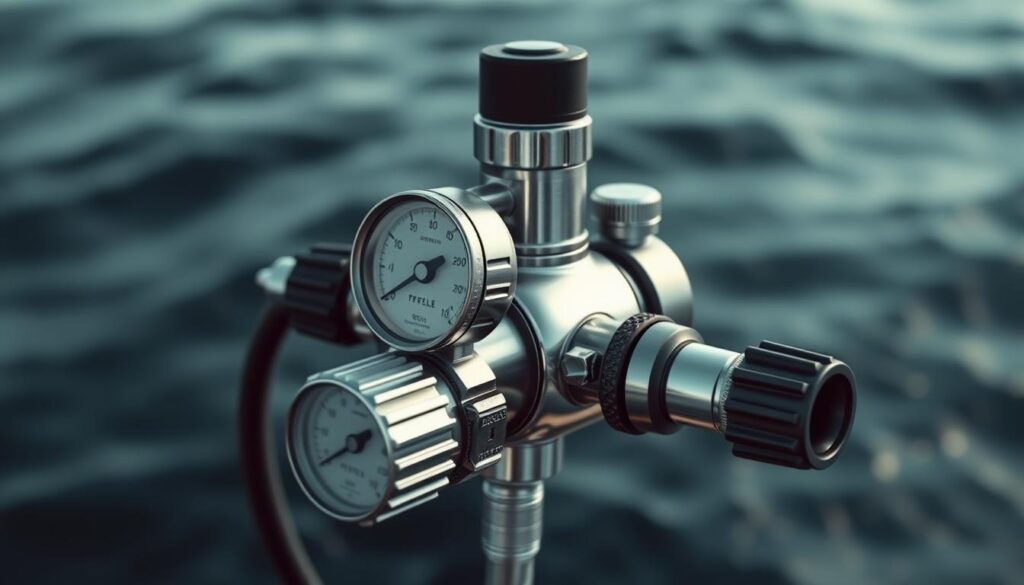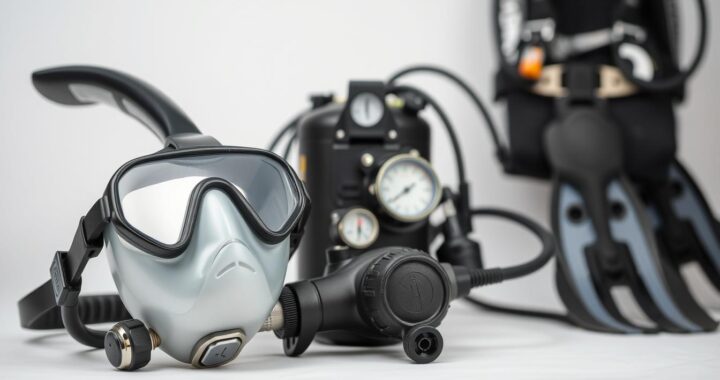Diving with the right gear is important for safety and fun. Our guide talks about all the essential equipment needed for diving, including masks, snorkels, wetsuits, and dive computers. It’s helpful for both new and experienced divers. Knowing about your gear helps make your dive safer and more fun. With the right equipment, you can enjoy the underwater world more. Your diving trips will be safe and memorable.
Key Takeaways
- Diving with the appropriate gear is crucial for safety and enjoyment.
- This guide covers all essential equipment for both new and experienced divers.
- Understanding scuba diving equipment functionalities enhances underwater experience.
- Using reliable and well-maintained gear helps you dive safely.
- Essential gear includes masks, snorkels, wetsuits, dive computers, and more.
Dive Masks
Dive masks are key for a good dive. They let you see clearly underwater and keep your eyes safe. It’s important to pick the right one for a great diving experience.
Choosing the Right Dive Mask
Finding the perfect dive mask means looking at fit, comfort, and style. Try different ones to see what works best for you. A good fit keeps water out and makes your dive better. Modern masks have features like clear views and are made of quality materials. These improve your time under the sea.
Mask Maintenance Tips
It’s key to take good care of your dive mask. Clean it with fresh water and gentle soap after each dive. This gets rid of salt and sand. Don’t use rough cleaners that can scratch it. Store your mask in a place that’s cool and dry, away from sun and harsh chemicals. Taking care of your mask means it will always work well for you.
Snorkels
Snorkels are not just for snorkeling. They are essential scuba diving gear pieces. They help divers save air at the surface. Picking the correct snorkel is key for a good dive. It helps divers find the perfect snorkel for their sea adventures.
Benefits of Using a Snorkel
Snorkels give scuba divers big benefits. They let divers breathe easy at the surface without using scuba tanks. This saves air for their dive. This is helpful when swimming to dive spots or during breaks at the surface. Snorkels also stop divers from swallowing water when the sea is rough. They make divers feel safer. For more details, check this guide.
Different Types of Snorkels
There are many kinds of snorkels for divers. Each type fits different diving needs and likes. The common types are:
- Dry Snorkels: They have a valve that closes the tube underwater. This stops water from getting in.
- Wet Snorkels: Old-school snorkels that need you to blow out water.
- Semi-Dry Snorkels: They have splash guards. These lessen but don’t stop water from getting in.
Choosing the right type of snorkel makes diving nice and fun. To learn more about snorkels, divers can look at online guides.
Scuba Fins
To make the most of your dives, you need good scuba fins. These items are key for a fun dive without getting too tired. Picking the right must-have scuba gear can really improve your underwater adventure.
Importance of Well-Fitting Fins
The right scuba fins help avoid cramps and discomfort. They need to fit snugly so they don’t slip off. This lets you move in the water well. Ill-fitting fins can make you tired and slow you down. It might even cause accidents. So, getting fins that fit right is a top priority.
Variety in Fin Types
There are different scuba fins for various diving activities. The main kinds are paddle fins and split fins. Here’s a quick look to help you choose:
| Type of Fin | Advantages | Disadvantages |
|---|---|---|
| Paddle Fins | Provides powerful thrust, ideal for strong currents | Can be more tiring for long dives |
| Split Fins | Less effort needed, good for long dives | Less effective in strong currents |
It’s important to pick the right fin type. Knowing the pros and cons helps you decide. Then you can pick the best must-have scuba gear for your dive.
Wetsuits
Wetsuits keep divers warm and safe from dangers in the water. They are key for a comfortable dive. They are made from neoprene. This material helps with warmth and floatation. The thickness of a wetsuit changes based on the water’s temperature.
When choosing a wetsuit, think about where you will dive. Cold water needs a thicker suit. But in warm water, a thin, stretchy suit is better. A good wetsuit fits well and lets you move freely.
| Water Temperature | Wetsuit Thickness |
|---|---|
| Above 77°F (25°C) | 1-3 mm |
| 60-77°F (16-25°C) | 3-5 mm |
| Below 60°F (16°C) | 7 mm or more |
Following these tips will make sure you pick the right wetsuits. This will help your dive go well.
Dive Computers
Dive computers are very important for scuba diving. They keep track of things like how deep you are, how long you’ve been underwater, and your decompression status. This helps keep you safe. Knowing how to use them makes diving better.
Why Dive Computers Are Essential
Dive computers are key parts of diving gear. They show real-time info to keep you safe under water. They help avoid dangers like decompression sickness. By doing hard math for you, dive computers make diving safer and more fun.
Choosing the Right Dive Computer
Finding the right dive computer depends on what you need. If you dive with nitrox, you’ll want one that can handle different gas mixes. Look for features like Bluetooth and easy-to-use screens. Think about your diving habits and budget to choose the best one.
Maintaining Your Dive Computer
Keeping dive computers working well is very important. Check the battery and update the software often. Taking good care of it after diving keeps it in good shape. This makes your gear last longer and keeps you safe.
Regulators
Regulators are key parts of any scuba diving setup. They send air from the tank to the diver. It’s very important to have good scuba gear for safe dives.
Importance of Reliable Regulators
Having reliable regulators is very important. They change high-pressure air in the tank to air you can breathe. Brands like Aqua Lung, Scubapro, and Mares are known for their strong scuba gear.

Regular Maintenance and Servicing
Keeping your scuba diving gear in good shape is key for its performance and safety. You should check your regulators often for wear. Having them serviced by a pro keeps them working well and safe to use in the water.
Here’s a quick guide to taking care of your regulators:
| Maintenance Task | Frequency | Details |
|---|---|---|
| Visual Inspection | Before Every Dive | Check hoses, fittings, and the mouthpiece for cracks or damage. |
| Functional Check | Before Every Dive | Ensure proper airflow and check for any unusual sounds. |
| Professional Servicing | Annually | Complete disassembly, cleaning, and testing by a certified technician. |
Scuba Gear Essentials
Knowing what scuba gear you need is key for safe fun underwater. A full checklist makes sure divers have everything they need.
Dive masks, snorkels, fins, wetsuits, dive computers, and regulators are core gear. Each piece helps with safety and comfort under the sea.
Dive masks let you see clearly underwater. Snorkels help you breathe near the surface. Fins make moving easier and less tiring. Wetsuits keep you warm in different water temps. Dive computers track depth and dive time for safety. Regulators ensure a steady flow of air.
Make quality and reliability top priorities for your scuba gear. Your gear must be safe and comfy. Choosing well-known brands and regular upkeep can make your dives better.
Surface Marker Buoys (SMBs)
SMBs help divers be seen by boats above. These tools are key for safety while diving up or in emergencies. Let’s look at SMBs and using them right.
What Are Surface Marker Buoys?
SMBs are tubes divers inflate to show where they are to boats and other divers. They are very important for staying safe, especially when it’s hard to see or there are many divers. Their bright colors and shapes make sure boats know where divers are.
Using SMBs Safely
It’s important to use SMBs the right way to stay safe underwater. Here are some tips:
- Inspection: Always check your SMB for any leaks before diving.
- Deployment: Get good at using your SMB at different depths. Mistakes can cause problems.
- Visibility: Make sure people can see your SMB from far away. Bright colors work best.
Following the rules for safe diving with SMBs makes diving much safer. Checking them often and using them right helps a lot in normal and emergency dives.
Conclusion
Scuba diving is exciting, but being prepared is super important. This guide has shown how to pick and take care of the right gear. Doing this makes your diving safer and more fun.
Start with a mask and snorkel that fit you well. Then choose the right fins and wetsuit. Adding cool tech like dive computers and trustworthy regulators is key. Using surface marker buoys also makes you safer in open waters.
Knowing the best scuba diving tips and keeping your gear in top shape is a must. This lets you enjoy the sea world to the fullest. Choose good gear, look after it well, and dive with joy and safety.
